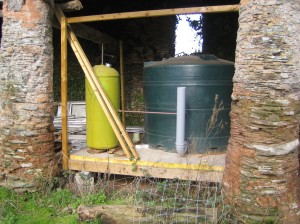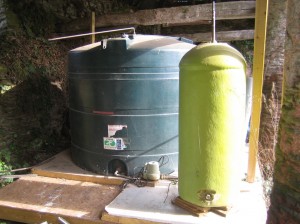Fans of the 1970’s BBC comedy series “The Good Life” will remember that Tom and Barbara had an electricity generator in the cellar that was powered using pig manure. What may be surprising is that it’s based on a fundamentally sound idea. Under the right conditions organic matter can be broken down by bacteria-like organisms (“composted”, if you will) to produce a mixture of carbon dioxide, hydrogen sulphide and methane. The CO2 and H2S isn’t too hard to extract, leaving methane which can be burned for cooking, heating, or in a generator. Small-scale digesters that do this aren’t at all uncommon in India and Africa where there are suitable “raw materials” and are often little more than one steel drum inverted inside another filled with the waste.
I’ve thought it would be fun for a while to try to build an AD unit myself and feed it chicken manure, kitchen waste and whatever else I could get my hands on for free. A friend gave me his old 2,500 litre oil tank (thanks Mark) and in fits and starts I’m making progress.
The first thing to do was to provide a large-bore pipe through which the tank could be filled and emptied. I decided to use 100mm soil pipe for this and fitted it into the tank using some flanges intended for large aquarium installations. I’ll seal them in place with silicon sealant.
The next problem is that ideally the contents of the tank needs stirring on a regular basis, but without letting all of the gas escape. As some form of heating is required to get the methane-producing beasties to work, I decided to use the pump circuit to swirl the contents of the tank around. I fitted a pipe from the original tap fitting into an old central heating pump and connected that to the bottom of the coil in a disused copper hot water cylinder. The top of the coil then goes into a second pipe that feeds back into the tank half-way up side, but where the bulkhead fitting goes back into the tank I’ve fitted a bend inside so the flow is back into the tank around the circumference. Hopefully that will start a stirring motion inside. The idea is that the hot water cylinder will be filled with hot water, initially heated by an immersion element, but subsequently perhaps by coolant from a generator and act as a large reservoir of heat to warm the contents of the tank, rather like a domestic heat store hot water system.
The filler cap has also been replaced with a clear perspex sheet allowing me to see inside (and which will seal tight to the top of the tank) and I’ve stood everything on a wooden platform on top of a couple of sheets of 50mm thick insulating material.
This is as far as I’ve reached so far. The next stage is probably to seal everything up and see if it can produce any gas at all, but before I do that I’ll built a cover of polythene sheeting to trap air around everything to try to retain some more heat. I’ll probably also lag the tank with a few layers of loft insulation, or perhaps even bubble-wrap.



your “part one” report on your AD project was on feb 28 2011. I don’t see any other entries on this project. I am interested to learn of your successes as well as your pitfalls.
Hello, I would also be very interested to see if yr AD project was a success after all yr testing? I have a quantity of horse poo that is building up by the day and would be interested to see if I can build sth like yours to digest it and get some heat/power from it. Does it work? Thanks. John